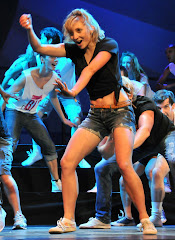La Leyenda
Photograph : Jesus Vallinas
The Ballet Nacional de España are performing a triple bill this coming week in London, and despite their company name & the fact that the company is made up in the same way as a ballet company, you can see from the stunning photographs that this show is not ballet in the traditional sense.
Nevertheless, I have seen authentic Spanish Flamenco shows in the past which have been stunning in atmosphere and visual imagery, and I think this will also be a show worth catching if you can.
What's more, some of the performances of Romance de Luna will be danced by Royal Ballet Principal dancer Tamara Rojo - who began her ballet training in Spain. It will be very interesting to see her take on a traditional Spanish style in a Spanish company, here in London.
Here are all the details you need :
Dualia / Romance de Luna / La Leyenda
Tuesday 27 April – Sunday 2 May 2010
Tickets: £15 - £55
During its 30 years, Ballet Nacional de España has performed in some of the most renowned theatres in the world and received some of the highest accolades including the Medalla de Oro al Mérito en las Bellas Artes, awarded to director José Antonio in 2005 by the Spanish Ministry of Culture. For their performances at the
London Coliseum, the company will perform two of their best loved works
Dualia and
La Leyenda with an additional piece,
Romance de Luna,
starring Royal Ballet principal Tamara Rojo to be performed on 27 April, 1 May at 8pm and 2 May at 4pm.
World Premiere at the Teatro de La Zarzuela of Madrid on 15th of March 2007
by Ballet Nacional de España.
Photograph : Josep Aznar
DUALIA
“Our intention with
Dualia was to deal with Spanish dance and breath in the youth and freshness of this generation with such a rich repertoire, reflecting ourselves in the colours of Sorolla’s paintings, seeking the complicity of pair dancing, interpreting the sensuality of looks, caresses, kisses, reminding ourselves of the great dancers our country has produced, to try to portray our meaning and feeling through the rasping of the castanets. Thank you José Antonio, we hold your air within, this one is for you, maestro”. Carlos Rodríguez and Ángel Rojas.
Dualia
Photograph : Josep Aznar
Cast
Introduction - capas
José M. Benítez, Eduardo Martínez, Isaac Tovar, Cristian García, Ángel Lara, Álvaro Marbán, Alfredo Mérida
First Movement
Elena Algado, Esther Jurado, Aloña Alonso, Tamara López, Jéssica de Diego, Maribel Alonso, Sara Calero, Carmen Coy, Lola Maeso, Yumi Saeki, Mª José Ramón.
Sergio García, José M. Benítez, José M. Buzón, Eduardo Martínez, Isaac Tovar, Jaime Cava, Francisco J. Caraballo, Antonio Correderas, Ángel Lara, Álvaro Marbán, Alfredo Mérida.
Second Movement
Tamara López – José M. Buzón (Days 27 and 29 April, 1 (matinée) and 2 May)
Aloña Alonso – Jaime Cava (Days 28 and 30 April, 1 (evening) May)
Third Movement
Miguel Ángel Corbacho, Jesús Carmona
Fourth Movement
Miguel Ángel Corbacho, Jesús Carmona
Elena Algado – Esther Jurado
Fifth Movement
Sergio García, José M. Benítez, José M. Buzón, Eduardo Martínez, Isaac Tovar, Jaime Cava, Francisco J. Caraballo, Antonio Correderas, Raúl González, Álvaro Marbán, Alfredo Mérida,.
Sixth Movement
Miguel Ángel Corbacho, Jesús Carmona
Elena Algado, Esther Jurado, Aloña Alonso, Tamara López, Jéssica de Diego, Maribel Alonso, Sara Calero, Carmen Coy, Lola Maeso, Yumi Saeki, Mª José Ramón.
Sergio García, José M. Benítez, José M. Buzón, Eduardo Martínez, Isaac Tovar, Jaime Cava, Francisco J. Caraballo, Antonio Correderas, Cristian García, Álvaro Marbán, Alfredo Mérida,.
La Leyenda
Photograph : Jesus Vallinas
ROMANCE DE LUNA
Cast
Tamara Rojo and Miguel A. Corbacho
La Leyenda
Photograph : Jesus Vallinas
LA LEYENDA
Of the artists and audiences who frequent today’s theatres, very few actually saw Carmen Amaya in a live performance. Those who did have that privilege define the experience with a single word: “strength”. Her dancing was, in fact, strong, intense, fast, stern. And all of this comes across in the pictures that have gradually forged this myth of Flamenco art, this universal symbol of Spanish temperament: Carmen on stage, arms back and head forward, as if ready to charge; Carmen dressed like a man; Carmen in typical flounced costume, flaunting her bare, incredibly muscular arms; Carmen kicking the train on her dress to heaven on high…
Those who like José Antonio knew her personally outside the clamour of the stage, however, can also attest to the fragility and humanity of this high-strung woman who was barely five feet tall.
La Leyenda (“The Legend”) springs from these memories in a modest personal tribute, a piece created by José Antonio with affection and admiration.
The proposal harbours no biographic or mimetic intention – Carmen was so utterly unique that any attempt at imitation would be futile -, but simply designs to portray, in images, an allegory of certain moments of her life and art, her strength and frailty, her grandeur and solitude, a dichotomy to which she and only she could be the antithesis.
In this awareness, the choreographer has had to resort to duality, gemination, to splitting the woman into two personalities, both opposite and complementary: Carmen, the woman in flesh and blood and Carmen, the immortal artist who ventured from Barcelona’s “tablaos” to the fame of the American stage; only to suddenly and unexpectedly depart, leaving behind the afterglow of her endless train for us to embrace, forever. Rosalía Gómez.
Cast
Characters
Ella Mujer: Cristina Gómez
Ella Inmortal: Elena Algado
1.- Introduction
Elena Algado
Women: Jéssica de Diego, Esther Esteban, Tamara López, Maribel Alonso, Mercedes Burgos, Sara Calero, Carmen Coy, Frida Madeo
Men: Jesús Carmona, José M. Benítez, José M. Buzón, Eduardo Martínez, Isaac Tovar, Francisco J. Caraballo, Jaime Cava, Antonio Correderas, Álvaro Marban, Alfredo Mérida
2.- Tangos
Cristina Gómez, Elena Algado
3.- Embrujo del Fandango
Cristina Gómez
4.- Rondeña
Rondeña Mujeres
Esther Jurado, Tamara López , Jéssica de Diego
Rondeña Hombres
Jesús Carmona (Days 27 and 29 April, 1 (matinée) and 2 May), José M Benítez (Days 28 and 30 April, 1 May (evening)), Eduardo Martínez, José M. Buzón, Álvaro Marban
Guitarists; Diego Losada, Enrique Bermúdez, Jonathan Bermúdez.
Singers; Sebastián Cruz (guest flamenco singer) Momi de Cádiz
Percussion; Amador Losada (guest percussion)
5.- Soleá
Miguel A. Corbacho, Isaac Tovar , José M. Benítez (Days 27 and 29 April, 1 (matinée) and 2 May)/ Jesús Carmona (Days 28 and 30 April, 1 May (evening))
6.- Alegrías
Cristina Gómez, Elena Algado
Guitarists; Diego Losada, Enrique Bermúdez, Jonathan Bermúdez,
Singers; Sebastián Cruz (guest flamenco singer) Momi de Cádiz
7.- Evolution
Aloña Alonso, Jéssica de Diego, Esther Esteban, Tamara López, Maribel Alonso, Mercedes Burgos, Sara Calero, Frida Madeo
José M. Benítez, José M. Buzón, Eduardo Martínez, Francisco J. Caraballo, Jaime Cava, Antonio Correderas, Álvaro Marban, Alfredo Mérida
8.- Memories (Ensueño)
Cristina Gómez, Elena Algado
9.- Rumba
Jéssica de Diego, Tamara López, Esther Esteban, Maribel Alonso, Mercedes Burgos, Frida Madeo
Miguel A.Corbacho, Jesús Carmona, José M. Benítez, Eduardo Martínez, Isaac Tovar, Francisco J Caraballo, Jaime Cava
10.- Seguiriya
Cristina Gómez, Elena Algado, Miguel A. Corbacho
Jéssica de Diego, Esther Esteban, Tamara López, Maribel Alonso, Mercedes Burgos, Sara Calero, Carmen Coy, Frida Madeo
Jesús Carmona, José M. Benítez, José M. Buzón, Eduardo Martínez, Isaac Tovar, Francisco J. Caraballo, Jaime Cava, Antonio Correderas, Álvaro Marban, Alfredo Mérida
11.- Epilogue
Please note that the company reserves the right to make changes to the cast.
BALLET NACIONAL DE ESPAÑA
Today, the Ballet Nacional de España (BNE) is facing a new creative period, with various projects and will take advantage of the opportunity to spread, preserve, and promote the extensive heritage of their already-historic repertoire under the direction of José Antonio, commissioned by the Ministry of Culture in 2004, being his second time as Director of the Ballet.
Founded by the Theatre and Entertainment General Direction of the Spanish Ministry of Culture in 1978, with the name of Ballet Nacional Español and with Antonio Gades as its first Artistic Director (1978-1980), the BNE has been directed by Antonio (Ruiz Soler) (1980-1983), María de Ávila (1983-1986), José Antonio (1986-1992), Aurora Pons, Nana Lorca y Victoria Eugenia (1993-1997), Aída Gómez (1998-2001) y Elvira Andrés (2001-2004).
The BNE is, among the projects of the National Institute for the Performing and Scenic Arts, one of the most known in the world, as ambassador of the Spanish culture. The Ballet has evolved in accordance with the new times and has known how to preserve its interest in all styles of Spanish dance, performing choreographies such as those of Escuela Bolera, flamenco and stylized Spanish dance. On the other hand, it has combined tradition and modernity, not forgeting main aspects as training and performing new projects.
During its 30 years, it has performed, in the most renowned theatres in the world, emblematic works as José Granero's “
Medea”, Mariema's “
Danza y Tronío”, Alberto Lorca's “
Ritmos”, José Antonio's “
Fandango de Soler”, Antonio's and José Antonio's versions of “
El Sombrero de Tres Picos”, Pilar López's “
El Concierto de Aranjuez”, and Antonio Gades's “
Bodas de Sangre” and “
Fuenteovejuna”.
The Ballet Nacional de España has been internationally acclaimed by audience and critics, obtaining various awards, such as Critics´ Prize for the Best Foreign Show during the 1988 season at the New York Metropolitan, the Japanese Critics´ Prize in 1991, the Critics´ Prize for the Best Spectacle at the Bellas Artes Theatre in Mexico City in 1994, a prize awarded by the Spanish newspaper, El País (Tentaciones), for “Poeta”, in 1999, and the Critics’ Prize as well as the Prize awarded by the audience at the VI Festival de Flamenco de Jerez de la Frontera (Spain), in 2002, for the choreography of “Fuenteovejuna” by Antonio Gades. In 2008, the BNE has obtained the prize “XVIII Teatro de Rojas (Toledo)” at Caprichos, Golpes da la Vida and Cambalache as well choreographies, awarded by the audience
Dualia was choreographed by two of flamenco’s hottest stars Rojas and Rodriguez, and explores the sensuality of looks and caresses through movement and music.
La Leyenda (The Legend) was choreographed by the company’s artistic director José Antonio as a tribute to the famous flamenco star Carmen Amaya who died in 1963. The piece portrays images from her life – from the slums of Barcelona to the glamour of performing on the American stage in the 30s and 40s.
Tamara Rojo won the 2010 Olivier Award for Best New Dance Production with choreographer Kim Bandstrup for a collaboration at the Royal Opera House called
Goldberg: The Brandstrup Rojo Project. The Spanish Prima Ballerina began her training in Madrid and joined The Royal Ballet as a Principal in September 2000.
BALLET NACIONAL DE ESPAÑA
Director
José Antonio
Principal Dancers
Elena Algado - Miguel A. Corbacho
First Dancer
Cristina Gómez - Esther Jurado - Jesús Carmona - Sergio García
Soloists
Aloña Alonso – Esther Esteban - Jéssica de Diego - Tamara López
José Manuel Benítez - José Manuel Buzón - Eduardo Martínez – Isaac Tovar
Ballet Corps
Maribel Alonso – Mercedes Burgos – Sara Calero – Lucía Campillo - Carmen Mª Coy – Frida Madeo - Lola Maeso Virginia Moro – Sara Nieto - Mª José Ramón - Yumi Saeki - Inmaculada Sánchez - Francisco Javier Caraballo - Jaime Cava - Antonio Correderas - Cristian García - José Manuel García – Alejandro García -Raúl González – Jonathan Guijarro – Antonio Jiménez - Ángel Lara - Álvaro Marbán - Alfredo Mérida
Ballet Masters
Elna Matamoros - Tino Morán - Raúl Tino
Master Rehearsal Director
Maribel Gallardo
Rehearsal Director
Juan Mata
Singers
Isabel Soto - Manuel Palacín – Momi de Cádiz
Guitars
Diego Losada - Enrique Bermúdez - Jonathan Bermúdez
Percussion
Samuel Flores
Pianists
Juan Álvarez - Juan José Sánchez
Director Assistant
Primitivo Daza

















.jpg)
.jpg)
.jpg)
.jpg)
.jpg)
.jpg)


.jpg)
.jpg)
.jpg)
.JPG)
.JPG)
+(2).jpg)
.jpg)
+(2).jpg)

.jpg_cmyk.jpg)
%2BLaurent%2BPhilippe_Rehearsal_Genus_Agnes%2BLetestu%2B%26%2BMathieu%2BGanio.JPG)

.JPG)
.jpg)
.jpg)
.jpg)
.jpg)
.JPG)











.jpg)




.jpg)



.jpg)






































